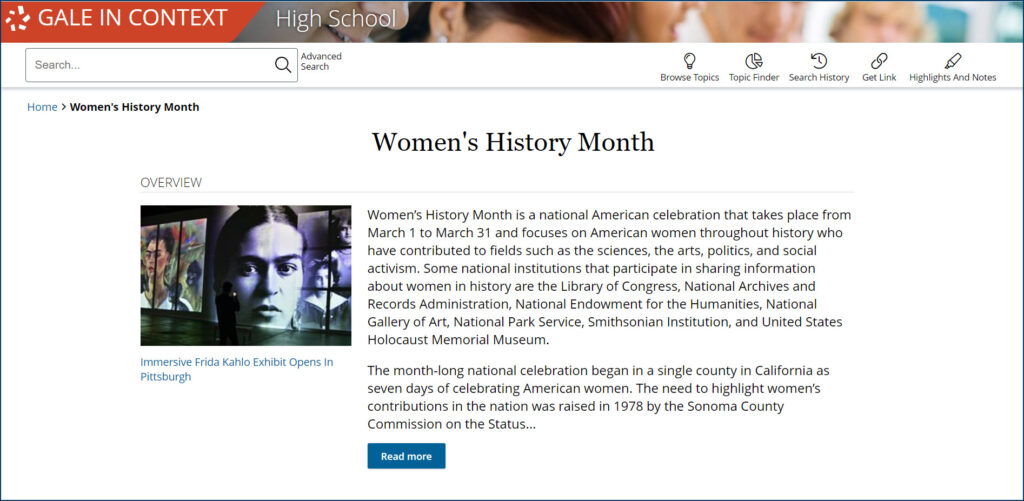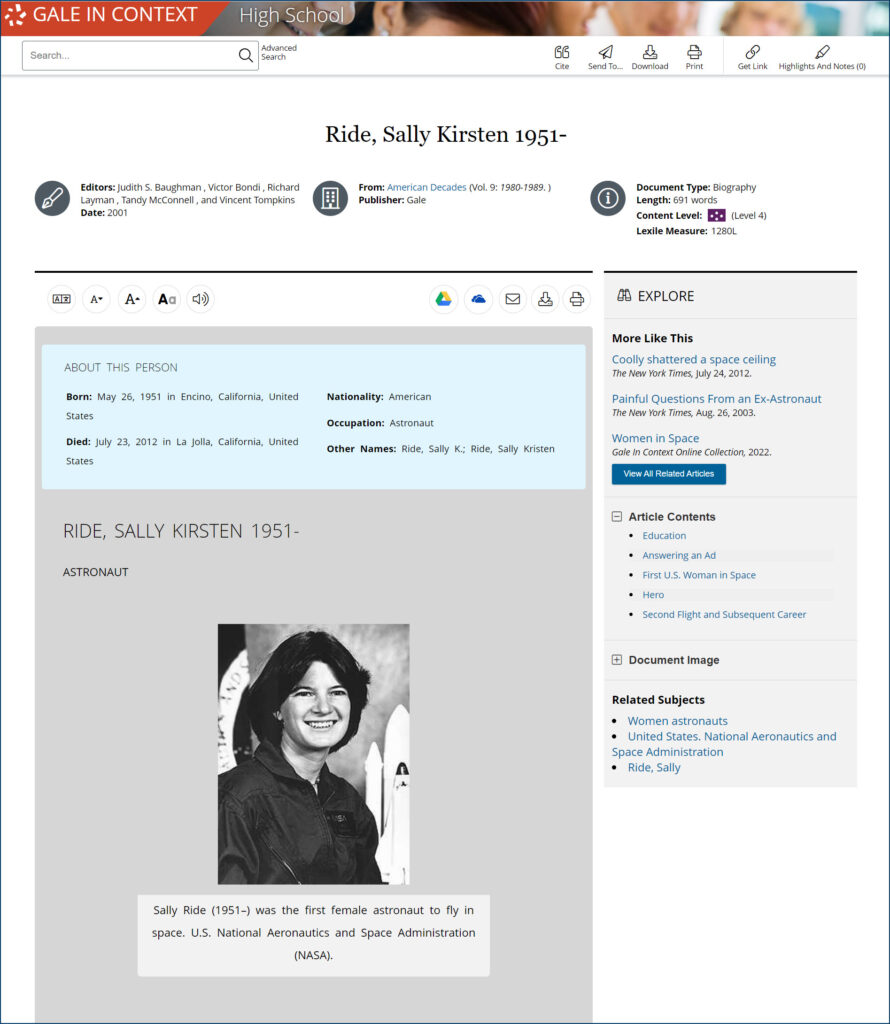| By Gale Staff |
Women’s History Month provides an excellent opportunity to discover important female figures and integrate their stories into your high school lesson plans. It’s a chance to reflect on the achievements of women throughout U.S. history and recognize their efforts toward equal rights for women. The spark for Women’s History Month started in a school setting, so it’s especially fitting to integrate these topics into your classroom. In 1978, a California-based education task force planned “Women’s History Week” alongside International Women’s Day on March 8th. The event claimed immediate notoriety in schools across the U.S., and in 1987, Congress proclaimed March as “Women’s History Month.”
Women’s countless contributions throughout American history span a range of expertise and professions. No matter what subject you teach, you can find a powerful woman whose achievements helped advance the field. However, their accomplishments are too often overshadowed by their male counterparts. With Gale In Context: High School, you and your students can give women’s stories the attention they deserve.
Your Gale subscription can help you weave Women’s History Month across your March lesson plans. The Gale In Context: High School database has a dedicated Women’s History Month portal with vetted resources across various subjects. From women in medicine to business, aviation, or outer space, our customized portal delivers top-tier content accessible to high school researchers. And, with Gale In Context: For Educators, you can leverage pre-built lesson plans, targeted assessment questions, and strategies for more inclusive learning. With these teacher-focused tools, you can spend less time planning and more time dedicated to student learning outcomes as you explore the incredible women who continue to change history.

Discover Equal Rights Activists
This year’s National Women’s History Month theme is “Women Who Advocate for Equity, Diversity, and Inclusion.” Kick off your March history lessons with the stories of women who fought discrimination while blazing new trails. Focus on key female activists who spoke out against the status quo and pushed for equal human rights regardless of gender, race, or ability.
Ida B. Wells
A former enslaved person turned journalist, Ida B. Wells is a crucial civil and women’s rights figure. She even has a dedicated portal in Gale In Context: High School. Born in the Deep South in 1862, Ida nonetheless attended university. She became an accomplished and outspoken writer against social injustice, publishing provocative exposés on violence against African Americans. Ida B. Wells significantly contributed to women’s suffrage alongside her civil rights activism. However, as a Black woman in the early 1900s, she wasn’t welcomed into traditional women’s suffrage circles, so she founded the National Association of Colored Women’s Club to help support women’s rights and fight segregation. In 2020, Ida B. Wells won the Pulitzer Prize for her courageous reporting.
Mabel Ping-Hua Lee
In 1912, Mabel Ping-Hua Lee was a young Chinese immigrant who became a women’s rights leader. During that period, because of the U.S. Chinese Exclusion Act, few Chinese immigrants were permitted into the U.S. However, Lee’s father, a Christian missionary, received special authorization to lead a church in New York City’s Chinatown. As a teenager, Lee was outspoken and brave, publishing articles and delivering speeches on justice and equality. She joined the women’s suffrage movement and, riding on horseback, helped lead a protest march of thousands of women up 5th Avenue. Sadly, as a Chinese immigrant, Lee could not vote alongside her comrades when the Nineteenth Amendment passed in 1920.
Recognize Female Contributions to Space Exploration
Women throughout history were pioneers across various industries, but there’s something especially captivating about women who not only broke the glass ceiling but helped us reach the stars. The STEM fields are still largely dominated by men, so make sure to elevate female leaders who contributed to scientific exploration, too.
Sally Ride
As of 2024, several dozen women have had the opportunity to fly in space, but few are as famous as Sally Ride. Born in 1951 in California, Sally was both athletic and bright. While pursuing a Ph.D. in physics from Stanford University, she answered a NASA advertisement for mission specialists. Out of thousands of respondents, NASA selected twenty-nine men and just six women for an astronauts-in-training program. In 1983, Ride joined the space shuttle Challenger crew and became the first American woman in outer space. Her fearlessness and intelligence helped prove that women could achieve the same as men and should be afforded equal opportunities.

Mary Jackson
Mary Jackson was the first African-American woman to join NASA. Born in 1921, Jackson was an excellent student and, in 1942, completed a Bachelor of Science in math and physical science. She accepted a position teaching math in a segregated school, though she would soon leave that job for various administrative roles. However, in 1951, recognizing her potential, the National Advisory Committee for Aeronautics (which would later become NASA) recruited Jackson to its computing unit dedicated to aerospace research. She excelled in her field, but after decades of performing aeronautical research, she ultimately decided to serve as the agency’s federal women’s program manager. This role allowed her to influence the hiring and training decisions; she was thus able to recruit and mentor the next generation of female engineers for NASA. Jackson faced segregation and pushback her entire life, yet she persevered and helped break down barriers for women of color in STEM.
Celebrate Today’s Female Heroes
Women’s History Month isn’t just about focusing on the past. Today’s students have countless modern role models fighting for social justice and equality. Greta Thumberg, Malala Yousafzai, and Amanda Gorman are examples of young women standing up and speaking out for some of the most pressing issues of our day. Encourage students to celebrate today’s heroes alongside those who changed history.
Sharice Davids
In 2018, Sharice Davids made history, becoming the first openly LGBTQ Native American elected to Congress. A respected mixed martial artist and Ivy League lawyer, Davids disregards traditional stereotypes. Before pursuing office, she dedicated her expertise to helping indigenous communities and advocating for diversity in business. In 2016, she worked in the Obama administration and became a respected political activist. She challenged incumbent Representative Kevin Yoder in the 2018 midterm elections and won by double digits.
Dolly Parton
Your students may recognize Dolly Parton as a famous musician, Miley Cyrus’ godmother, and celebrated feminist icon, but her story is a fascinating and inspirational journey. Born in 1946, Dolly Parton’s family lived in severe poverty. However, they were involved in the church, which allowed Parton to engage with music at an early age. She loved performing, and at age 12, she scored a slot at the Grand Ole Opry. Throughout her career, Dolly Parton has earned 54 Grammy nominations (10 wins) and sold more than 100 million albums worldwide. She uses her platform to speak out for humanitarian causes and tolerance.
Highlighting female pioneers helps create powerful role models across traditional male-dominated industries. We must integrate women’s stories into shared learning spaces; they help us teach the value of perseverance despite the odds. Furthermore, women’s rights are a critical piece of human rights. We can learn a lot from those who fought and still fight similar battles. With Gale in Context: High School, all students can access accurate, inspiring information on activists, journalists, scientists, astronauts, musicians, and more. Gale can help you share their incredible stories and inspire the next generation to continue to push for equality.
Contact your local representative today to request a trial if you would like to learn more about Gale In Context: High School and other Gale products.

